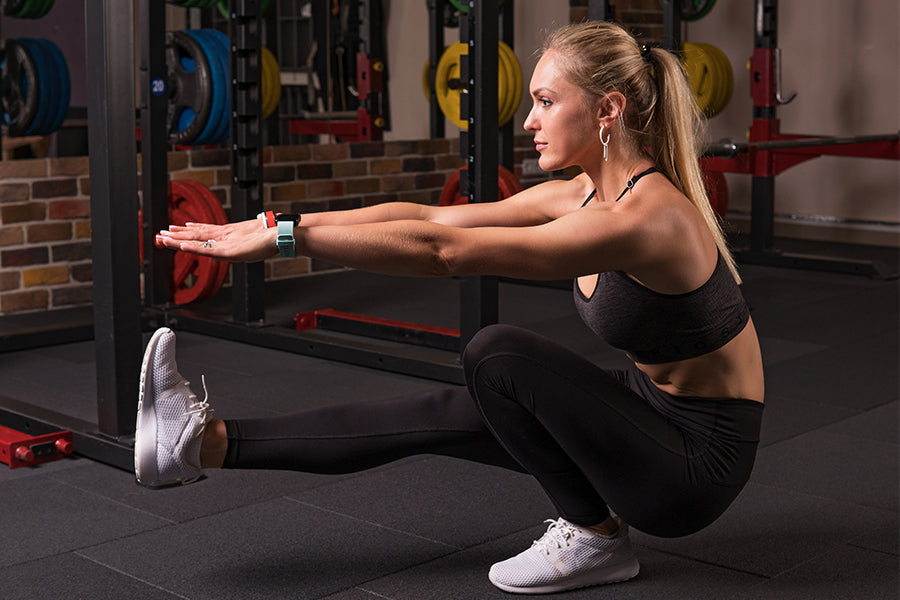Are you looking to improve your strength and agility while adding some serious style points to your workout routine? Then it's time for you to master the pistol squat. This ultimate lower body exercise will do plenty of good for your body and killer looks.
In this post, we'll go over all the basics of a proper pistol squat, including how to set up correctly, which muscles are involved, and tips on the form that will help you nail this impressive movement.
So roll out those yoga mats, grab a spot in front of the mirror (trust us, you’ll want one), and get ready for an ultra-intense leg day with the king of squats - the Pistol Squat.
What is a Pistol Squat?
The pistol squat can be a daunting exercise, with its high mobility, stability, and strength requirements. But don't worry; it’s well worth the effort for one simple reason: real-world results.
Not only does it help build unilateral strength and challenge your balance and coordination, but it beats “burpees” any day of the week. After mastering this pro move, you'll be feeling better than ever. To do it:
- Stand with your feet shoulder-width apart, and raise your arms till they are in front of you at the level of your shoulder. Now pull your shoulder back while engaging your core.
- Lift one leg and try to hold it in front of you in a raised position.
- Lower into a squat by bending your supporting knee, and keep your upper body and back as straight as possible.
- Make sure your butt is close to your supporting heel, engage your glutes, and use that heel to lift yourself.
- Return to your starting position.
- Repeat on the other leg.
Related Article: Get Bigger Glutes: Extreme Butt Builder Workout
When to Do the Pistol Squat
Pistol squats are an excellent option for leg and full-body workout days, as all you need is yourself and some dedication. Aim to work on these progressions three to four days each week so you can hone your form - once you get it down, keep it in your repertoire and perform low reps and limited sets, such as 3 sets of 5 reps on each leg.
Allowing yourself enough time to master something like the pistol squat builds a strong foundation on which you can continue building strength and physique.
Pistol squats are one of the most challenging exercises, but they sure pack a punch when building strength - particularly in your glutes, quads, hamstrings, and hip adductors. They're great for training balance and stability while engaging your core muscles.
Just be sure that you start slowly and with proper form so you don't end up looking like a sack of potatoes on the floor. So grab a spotter, set aside some time for practice, and get ready to reap the benefits of this phenomenal move.
Related Article: Hamstring Curls — 6 Variations to Spice Up Your Next Leg Day
Benefits of Pistol Squats
Pistol squats are an amazing exercise that has innumerable benefits for your body. Not only do they help tone, strengthen, and develop flexibility in muscles throughout your lower body, but they also require you to use stabilizing muscles, often giving you a full-body workout.
Additionally, pistol squats can help people become more agile on their feet as the exercise helps improve balance, coordination, agility, and posture. Lastly, this exercise is great because it requires no equipment aside from your body weight, making it easy to do anywhere.
Pistol squats can be a great way to layer strength and stability on top of your running. And don't worry, you don't have to be a runner to get in on the action — hikers, climbers, and sports players alike can benefit from adding these tricky one-legged squats into their routine.
But watch out! Like any fitness feat worth doing, getting pistol squats right means mastering your form first. Don't skimp on taking time to practice, and ensure you're squatting with good technique - otherwise, you could end up sore, tired, and hurt.
Related Article: 8 Balance Improving Exercises That Build Stability, Strength & Flexibility
Downsides to Pistol Squats
The pistol squat is tricky; trying it before mastering your practice can cause injuries that may be too hard to recover from. Here are some downsides to the exercise you need to know before you give it a try.
- Trying pistol squats before you’ve mastered your balance and muscle control.
- Leaning too forward can cause stress on the lower back.
- Lowering down into the bottom of a squat too hard or in an uncontrollable way.
- Raising your back heel from the floor and putting focus and weight into a smaller or sensitive area.
- Rolling your back to get up from the squat instead of using your glutes and heel.
- Having misaligned hip, knee and ankle during the movement.
Related Article: Exercises to Ease Your Back Pain, Restore Your Health
Pistol Squat Progressions
Before tackling the pistol squat, build the muscles in your lower body with squats, lunges, calf raises, and step-ups — explicitly focusing on bilateral symmetry and ensuring both legs can handle the load.
This will give you a solid foundation to work off of when you start practicing the pistol squats. If you have any pre-existing injuries in your knees or ankles, then make sure to chat with a doctor first — they’ll be able to advise whether these starter exercises or lighter versions of the pistol squat might benefit your recovery.
FAQs
1. What are the benefits of pistol squats?
These one-legged squats help you build balance and coordination. They also strengthen both your big muscle groups and stabilizers alike. From firmer glutes to toned hip flexors, pistol squats target all sorts of muscles with the added plus of increased core strength.
2. How many pistol squats are good?
The answer is whatever works best for you. It doesn't matter if it's three or twenty — just make sure it's challenging enough to push your limits but not so much that it causes injury. Not everyone has the same fitness level, so no exact number of pistol squats will work for everyone.
3. Are pistol squats hard?
Pistol squats are a demanding exercise requiring a lot of strength and serious flexibility. If you've seen someone do one, they look pretty challenging to pull off. It takes time and commitment.
4. Are pistol squats bad for knees?
When it comes to pistol squats, there is no simple answer to whether they’re bad for knees. Many experts argue the movement is safe if done correctly, while just as many point out, it places a tremendous amount of stress on the knees and can easily be done wrong.
The Bottom Line
The pistol squat is a challenging exercise that requires proper practice to perform correctly. It targets your glutes, hamstrings, quads, and hip adductors that provide you balance, stability, and engage core muscles. They also improve coordination and posture and help you gain a fantastic body. The package also comes with strains and injuries that require a proper check. Try the exercise, help yourself get into good shape, and consider its downsides to avoid mistakes. Happy Muscles!
Reading List
Article Sources
- Khuu, Anne, et al. ‘NOT ALL SINGLE LEG SQUATS ARE EQUAL: A BIOMECHANICAL COMPARISON OF THREE VARIATIONS’. International Journal of Sports Physical Therapy, vol. 11, no. 2, Apr. 2016, pp. 201–11. PubMed Central, https://www.ncbi.nlm.nih.gov/pmc/articles/PMC4827363/.








